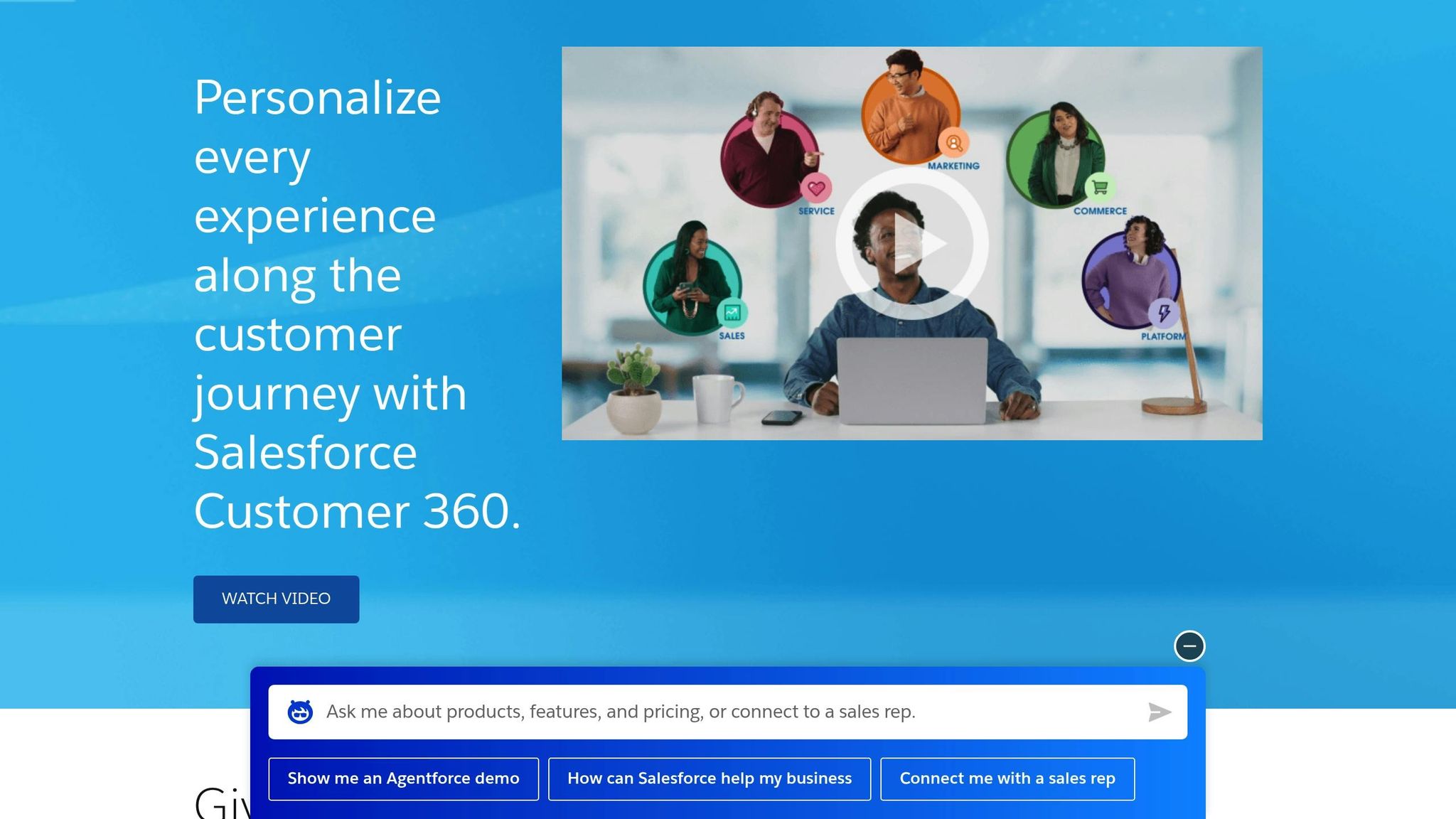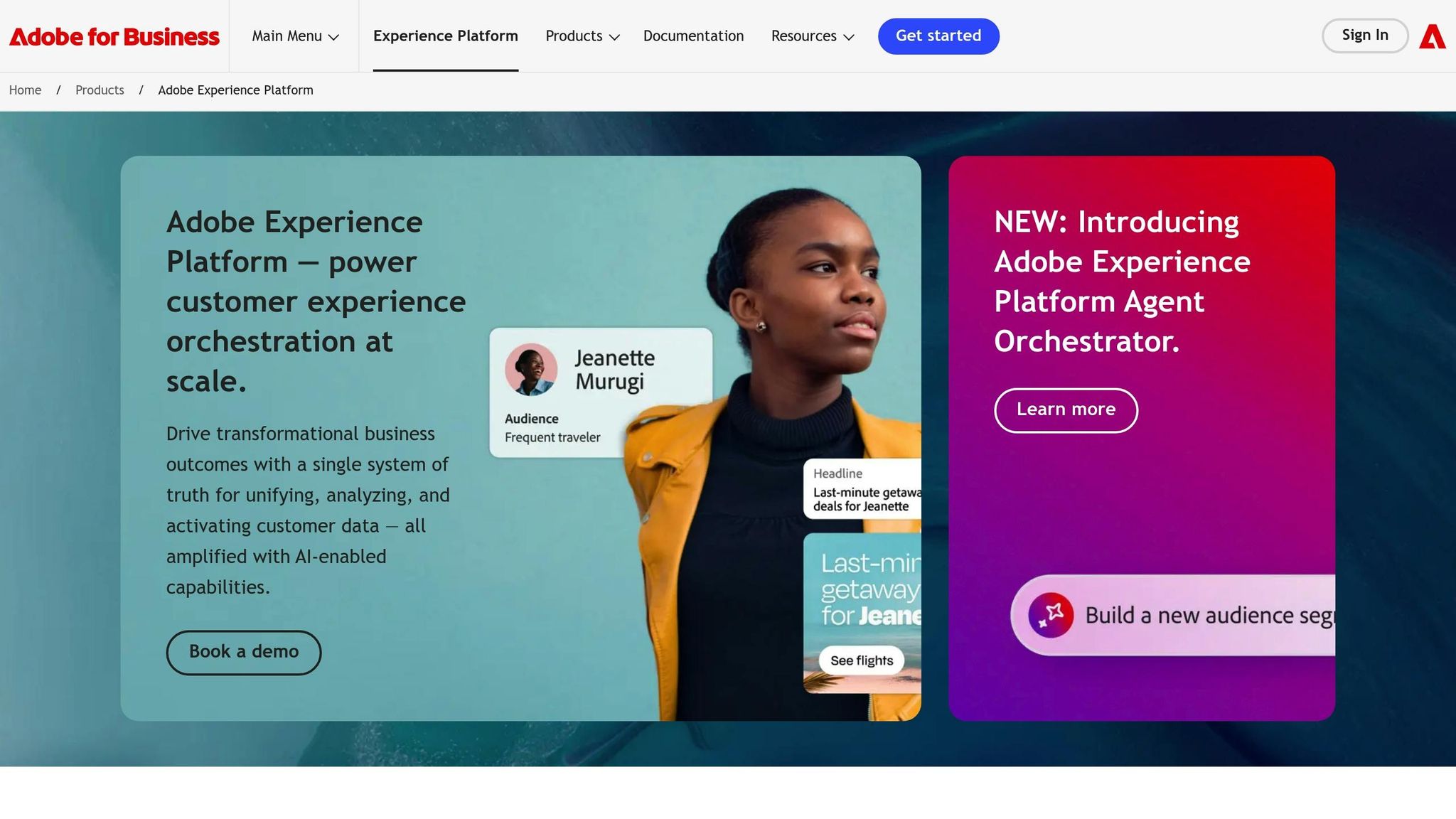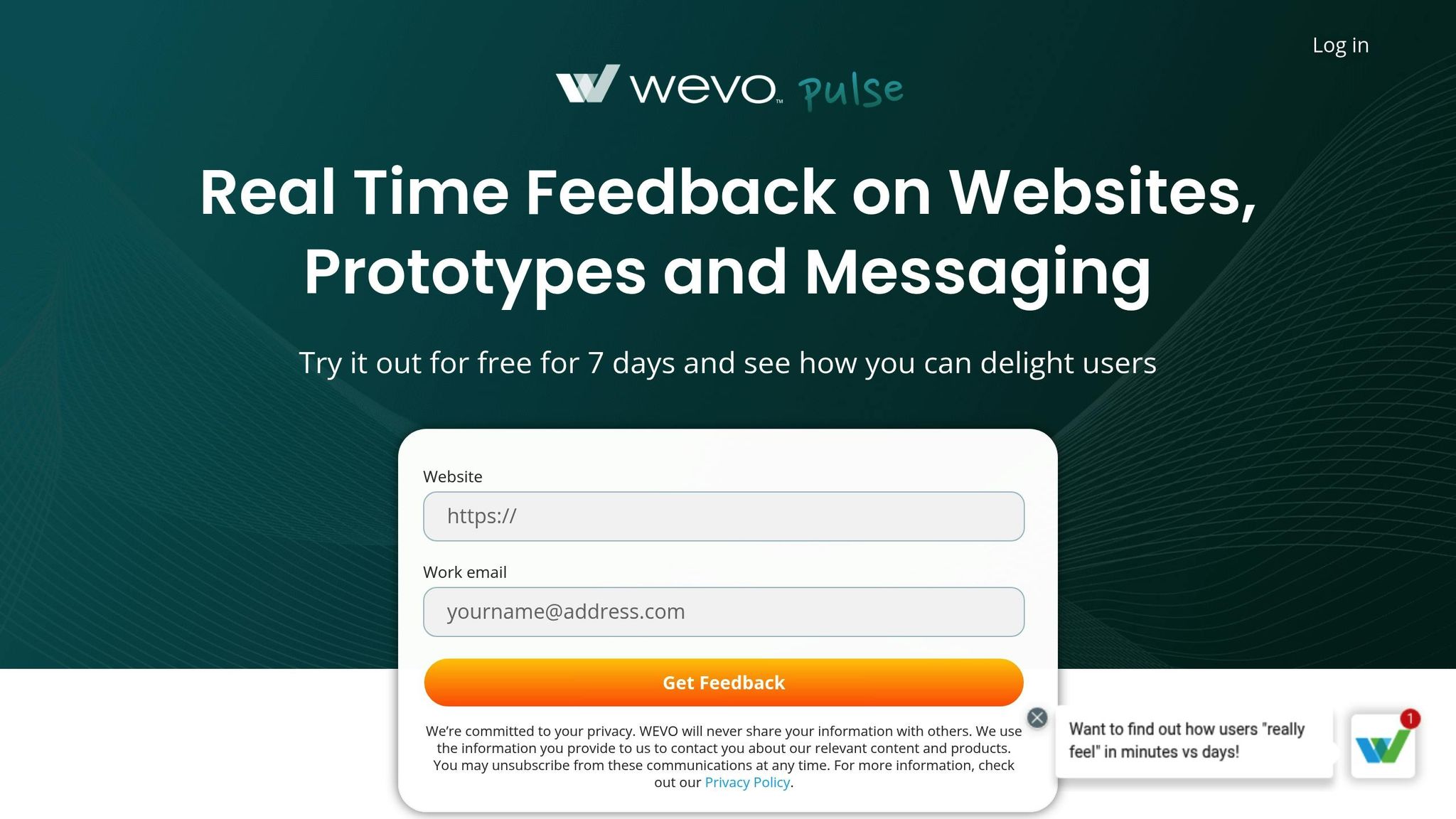Creating tailored experiences for customers isn’t just a trend - it’s a necessity. Personalized marketing can boost ROI by 5–8×, increase sales by 10% or more, and drive 42% higher conversion rates with customized calls-to-action. Yet, 87% of marketers still struggle to use data effectively, leaving billions in missed opportunities.
Here’s a quick look at 6 tools that can help you leverage data for smarter, more personalized marketing:
- Nudge: Focuses on behavioral data to create real-time, cross-platform personalization.
- Bloomreach: AI-driven insights for real-time personalization and seamless customer journeys.
- Salesforce Customer 360: Combines AI, CRM, and data for unified, personalized interactions.
- Adobe Experience Platform (AEP): Real-time data processing for omnichannel personalization.
- WEVO Pulse: Instant feedback on customer experience to refine strategies fast.
- ChatGPT: AI-powered content creation and personalization for every stage of the customer journey.
Quick Comparison
| Tool | Focus Area | Key Feature | Best For |
|---|---|---|---|
| Nudge | Behavioral data | Real-time triggers and journey mapping | Apps and cross-platform use |
| Bloomreach | AI-driven insights | Predictive personalization | E-commerce and retail |
| Salesforce 360 | Unified customer view | CRM + AI for predictive analytics | Large-scale businesses |
| Adobe AEP | Omnichannel personalization | Real-time customer profiles | Enterprise-level marketing |
| WEVO Pulse | UX feedback | Rapid testing and insights | Improving web and mobile UX |
| ChatGPT | Content personalization | AI-generated tailored messaging | Content-heavy strategies |
These tools simplify personalization, helping businesses meet rising customer expectations while improving engagement and conversions. Dive deeper into the article to find the best fit for your needs.
What Tools Can You Use For Dynamic Content Personalization? - TheEmailToolbox.com
1. Nudge
Nudge is a behavioral intelligence platform designed to turn customer data into tailored, meaningful experiences. By analyzing user behavior, it enables consumer businesses to automate personalization through precisely timed interactions. Let’s break down how its AI capabilities, real-time integration, journey enhancement, and cross-platform support create impactful personalization.
AI-driven personalization
Nudge’s AI engine is built to predict user needs and serve up recommendations at just the right moments. By analyzing customer data, it identifies patterns and triggers, letting businesses engage users when they’re most likely to act. This dynamic segmentation and in-app personalization not only enhance engagement but also improve retention rates.
For instance, Shadowfax used Nudge to promote their "One Click" feature, leading to a 69% increase in adoption. By applying behavioral psychology, they encouraged users to provide feedback and complete their first orders, improving both operations and customer interaction.
The effectiveness of this approach is backed by data: a March 2023 survey found that 84% of marketers consider aligning web content with search intent to be the most effective application of AI in marketing automation.
Real-time data integration
Nudge brings customer data together from multiple sources to create a unified, 360° view of each user. This real-time integration powers automated triggers for personalized offers and reminders, ensuring timely and relevant interactions.
Personalization has a powerful impact: 78% of consumers are more likely to recommend businesses that provide tailored experiences. By leveraging real-time data, Nudge helps businesses deliver seamless, optimized customer journeys.
Optimizing the customer journey
Through data-driven insights, Nudge refines key touchpoints across the user journey to boost conversions. Its AI Decisioning Engine dynamically adjusts layouts, calls-to-action, and interfaces based on user behavior. From full-page changes to subtle micro-interactions, the platform personalizes every step of the journey for each individual.
The benefits of this approach are clear. Companies that focus on managing customer journeys report a 50% higher ROI on marketing efforts and a 25% improvement in operational efficiency when journey management is integrated into their digital strategies.
Cross-platform functionality
Nudge takes a "build once, personalize everywhere" approach, offering seamless deployment across Web, iOS, Android, Flutter, and React Native. Its native SDKs provide real-time data syncing, quick implementation, and unified targeting - without overloading engineering teams. This ensures users can move effortlessly between platforms without losing their personalized experience.
The results speak for themselves. Businesses that adopt omnichannel strategies often see an 80% increase in incremental store visits, while advanced personalization efforts can lead to a 20% boost in sales. Nudge’s cross-platform capabilities make it easier than ever to deliver consistent, personalized experiences across all channels.
2. Bloomreach

Bloomreach is a platform that transforms raw data into personalized customer experiences. It offers tools for managing unified customer data, generating AI-driven insights, and orchestrating strategies across multiple channels. Powered by its Loomi AI engine, Bloomreach enables businesses to create tailored, data-driven narratives that resonate with their audience. Its features focus on boosting performance through AI insights, real-time data integration, and customer journey optimization.
AI-powered personalization capabilities
Bloomreach’s AI engine takes personalization to the next level by understanding customer intent - even when it’s not explicitly stated. By analyzing user behavior, such as clicks, browsing habits, and demographic details, the platform delivers experiences that adjust in real time.
For example, Yves Rocher leveraged Bloomreach’s personalized recommendations in 2024, resulting in an 11× increase in purchase rates. Similarly, HP Tronic saw a 136% jump in new customer conversion rates. The AI also predicts customer churn, suggests optimal times for communication, and tailors content to individual preferences. Benefit Cosmetics used AI-triggered email sequences, which led to a 50% boost in click-through rates and a 40% increase in revenue.
Real-time data integration
Bloomreach excels at real-time personalization, creating anonymous user profiles as visitors interact with products. This allows the platform to adapt instantly to each user’s behavior.
The Vitamin Shoppe, for instance, delivers product recommendations within just 0.1 seconds of a user’s action, leading to an 11% increase in add-to-cart rates on category pages. During Black Friday weekend in 2025, TFG (The Foschini Group) experienced a 35.2% rise in online conversion rates, a 39.8% increase in revenue per visit, and a 28.1% drop in exit rates. Baby-walz used real-time insights to craft email campaigns tailored to customers’ pregnancy stages, achieving a 53.8% boost in average open rates.
Customer journey optimization
Bloomreach focuses on optimizing the entire customer journey, not just individual touchpoints. By combining its customer data platform (CDP) with machine learning and omnichannel tools, the platform ensures seamless experiences across all channels.
The Thinking Traveller used personalized "shortlist guidance cards" alongside villa listings. In just 10 days, this approach led to a 33% increase in inquiries from users who interacted with the guidance.
"Our reengagement journey used to speak broadly to customers without taking their unique needs into account. Now, we can personalize them, reaching every single person on the right channel with the right message." – Victoria Pinion, Assistant CRM Manager
Bloomreach also supports A/B testing across various channels, enabling marketers to refine strategies based on actual performance. HMV utilized this feature to segment audiences and personalize ad campaigns, resulting in a 14% week-over-week revenue increase.
Cross-platform compatibility
Bloomreach ensures consistent personalization across all platforms, from websites and mobile apps to email and social media. This unified approach allows businesses to maintain seamless customer experiences.
For example, Bimago, an interior decoration retailer, introduced personalized subscription banners that dynamically adapted to user behavior. This strategy led to a 44% increase in conversions. The platform’s ability to share customer insights across channels ensures that preferences identified in one area enhance personalization everywhere, fostering stronger relationships and higher engagement throughout the marketing ecosystem.
3. Salesforce Customer 360

Salesforce Customer 360 brings together AI, data, and CRM to create personalized experiences across every interaction. By connecting customer information from sales, service, marketing, and commerce, it provides a unified view that helps businesses make smarter and quicker decisions. With its Einstein AI engine and advanced data integration features, the platform transforms raw data into actionable insights, enabling personalization on a large scale.
AI-powered personalization capabilities
Salesforce Customer 360 uses Einstein AI to analyze customer data and behaviors, delivering real-time personalization that aligns with individual preferences. It processes both historical and live data to identify trends and recommend products based on browsing habits, purchase history, and demographic details. Predictive analytics from Einstein also help businesses anticipate customer needs - whether it’s identifying when someone might leave, determining the best time to reach out, or suggesting relevant products or services. AI chatbots further enhance this by collecting interaction data and offering tailored recommendations.
General Mills provides a great example of this in action with a personalized recipe recommendation system. Heather Conneran, Director of Brand Experience Platforms at General Mills, shares:
"The combination of AI, data, and CRM allows us to help busy parents solve the 'what's for dinner' dilemma with personalized recipe recommendations their family will love."
The platform’s AI also sharpens targeted advertising by analyzing customer patterns for precise audience segmentation. Dynamic pricing features adjust costs in real time based on factors like demand, competition, and individual customer value - ensuring businesses optimize revenue while maintaining a personalized customer experience.
This advanced use of AI ensures that every interaction is informed and tailored, laying the groundwork for seamless data integration.
Real-time data integration
At the heart of Customer 360 is its Data Cloud, a powerful customer data platform (CDP) that captures and unifies information from any source in real time. This integration allows businesses to instantly understand customer preferences, predict behaviors, and create highly targeted marketing campaigns. Real-time updates ensure that as customers browse, abandon shopping carts, or engage with content, their profiles are immediately refreshed to guide future interactions.
Nationwide successfully used AI-driven marketing personalization to target nearly 14 million prospects and customers. This effort converted over 1.3 million prospects into known customers, with paid search campaigns significantly boosting engagement and time spent on their site. Additionally, Customer 360 addresses a common challenge: while 76% of customers expect consistent interactions across departments, only 54% feel that sales, service, and marketing teams share information effectively.
By unifying data flows, the platform ensures a cohesive customer journey across all channels.
Customer journey optimization
Salesforce Customer 360 takes customer journey optimization to the next level by connecting interactions across all channels and departments. It uses insights to customize each journey, ensuring that the customer experience is seamless from start to finish. Its federated approach keeps original data intact while mapping it for quick access, ensuring that customer context moves smoothly between marketing, sales, and service teams.
Patrick Stokes, Executive Vice President of Platform Shared Services at Salesforce, explains the platform’s mission:
"Customer 360 is our vision for how we help customers with their digital transformations. It's all of the technology and services that we develop to enable our customers to deliver the intelligent, personalized experiences their customers have come to expect from every brand."
This optimization is crucial as 80% of customers now rate the experience a company provides as equally important as its products or services. By breaking down internal silos and promoting consistent information sharing, Customer 360 helps businesses meet these rising expectations.
Cross-platform compatibility
Customer 360 ensures that personalization is consistent across websites, mobile apps, email campaigns, social media, and even in-person interactions. Insights gathered from one channel instantly enhance the experience across all others. The platform also includes industry-specific tools that deepen customer understanding at every touchpoint, whether digital or face-to-face.
Customers using Salesforce Personalization have seen conversion rates improve by over 200%, showcasing the impact of delivering consistent cross-platform experiences. However, success in personalization requires strong collaboration between teams. Zach Mason, MarTech team lead at Nationwide, emphasizes:
"Collaboration across marketing and technology teams is critical for successful personalization. Clearly defining roles, responsibilities, and processes ensures seamless handoffs and efficient execution."
Data privacy remains a concern for many customers, with a 2023 Gartner survey revealing that 59% of people don’t trust companies with their data. Salesforce Customer 360 addresses this by incorporating robust privacy controls and clear data governance policies, balancing personalization with the need to maintain customer trust.
sbb-itb-a84ebc4
4. Adobe Experience Platform (AEP)

Adobe Experience Platform (AEP) combines the power of AI with real-time data processing to create unified customer experiences. It fuels Adobe Experience Cloud applications, enabling teams to make fast, data-driven decisions while orchestrating personalized customer interactions in real time.
AI-Powered Personalization
AEP uses advanced AI and machine learning to transform raw customer data into actionable insights. By leveraging AI-driven predictions, the platform helps businesses understand customer preferences and anticipate their likelihood to convert. This enables companies to deliver experiences that feel tailored and relevant. With over 80% of Adobe Experience Cloud customers already using these AI capabilities, AEP has proven its ability to scale personalization efforts effectively.
In March 2023, Adobe introduced Sensei GenAI technology, which equips marketers with predictive insights and intelligent decision-making tools. These features allow brands to offer more personalized experiences faster. For example, the platform can identify the next best offer based on real-time intent signals and profile data, ensuring promotions align with customer behavior.
AEP also integrates tools like the Adobe Experience Platform Agent Orchestrator and AI Assistant, which help teams act on insights immediately. With 72% of consumers expressing trust in AI to improve their interactions with brands, businesses can confidently adopt AI-driven personalization strategies that resonate with their audiences. This seamless integration of AI insights allows AEP to deliver real-time, personalized experiences.
Real-Time Data Integration
AEP brings together data from Adobe and non-Adobe sources instantly, enabling businesses to personalize experiences in real time while maintaining data governance and privacy standards. This capability supports intelligent re-engagement campaigns, optimizes conversions, and enhances contextual recognition - all of which boost customer lifetime value. In fact, companies using Adobe solutions have reported an impressive 431% return on investment.
By unifying data in real time, AEP lays a strong foundation for optimizing the entire customer journey, ensuring that every interaction feels relevant and timely.
Optimizing the Customer Journey
AEP shines when it comes to orchestrating customer experiences across multiple touchpoints. Its integration with Adobe Journey Optimizer - built directly on AEP - enables businesses to design and deliver personalized experiences across various channels. Companies using AEP have seen a 62% increase in personalized campaigns and a 90% reduction in data latency, leading to better customer experiences and higher conversion rates.
By eliminating complex integrations, AEP allows marketing teams to focus on strategy and execution. The platform’s real-time customer profiles, centralized offer decision-making, and AI capabilities work together to streamline and enhance customer journeys.
Seamless Cross-Platform Integration
AEP’s architecture ensures smooth integration across the Adobe Experience Cloud ecosystem and beyond. The platform connects with a wide range of partners and offers native integrations with Adobe Experience Cloud applications, ensuring consistent personalization across websites, mobile apps, email campaigns, and other digital channels.
Its API-first framework makes it easy to integrate with existing tech stacks, while Adobe Customer Journey Analytics links customer identities and interactions across channels. This provides businesses with a comprehensive view of customer behavior. AEP’s ability to maintain consistent messaging across channels underscores the importance of data in crafting personalized marketing strategies.
5. WEVO Pulse

WEVO Pulse is reshaping how businesses analyze customer experiences by combining AI with insights from over 1 million participants. It delivers feedback 100 times faster than traditional methods, empowering marketers to personalize strategies with unmatched speed.
AI-Powered Personalization Capabilities
Using generative AI, WEVO Pulse dives deep into digital experiences, offering instant insights into user needs and sentiments. This enables marketers to zero in on specific personas, tailoring strategies to their unique customer base.
"WEVO Pulse is a breakthrough in UX testing because it allows product, marketing, and design teams to rapidly and cost-effectively test digital designs, products, and campaigns instantly at every step of the design process. Rather than waiting days for results from research involving panels, Pulse combines insights gained from over 1 million human participants with patterns recognized by artificial intelligence."
– Nitzan Shaer, CEO and co-founder of WEVO
The platform evaluates key metrics like usability, trust, and value on websites, giving marketers a clear picture of their site's performance from a customer experience perspective. A great example: Columbia Southern University used WEVO in 2023 to analyze their webpages. By acting on the platform’s recommendations, they achieved a 160% increase in website conversions.
"Thanks to WEVO's easy to use platform and amazing customer service I was able to get great insights on my webpages with no hassle. With their recommendations, conversion on my website has increased by 160%."
– Jim Bills, Digital Marketing Director at Columbia Southern University
Real-Time Data Integration
WEVO Pulse stands out by providing real-time analysis of digital experiences. Marketers receive actionable feedback almost instantly, allowing them to make improvements without delay. Its Chat feature adds another layer of convenience, enabling users to get immediate insights and suggestions. Forget the days of waiting weeks for research results - this platform delivers fully formed insights in just five minutes.
"WEVO Pulse has already sparked deep interest across Accenture Song. Our current beta testing of the platform has outperformed expectations week over week providing stimulus for further directional human investigation at the speed of query. We are able to just 'take a pulse' and see fully formed insights within five minutes."
– Gillian Salerno-Rebic, Manager, Experience Strategy and UX Research Practice Lead at Accenture
This rapid feedback loop helps businesses make swift, impactful improvements to their customer journeys.
Customer Journey Optimization
One of WEVO Pulse’s standout features is its ability to assess entire customer journeys, not just individual pages. By identifying specific drop-off points, it uncovers pain points like confusing navigation or lengthy checkout processes that lead to cart abandonment. This holistic approach is particularly effective for refining checkout flows and other critical touchpoints.
In 2023, Jackson Hewitt used WEVO Pulse to gather customer insights and quickly optimize their landing pages. This approach allowed them to launch high-converting pages faster than ever.
"We leveraged WEVO to have customer insights and quick feedback so that our team could launch out of the gates with higher converting landing pages. By enlisting WEVO, Jackson Hewitt achieved faster test results along with highly optimized landing pages and creative, all before going live."
– Euan Campbell, CMO at Jackson Hewitt
Accenture Song also saw significant results, using WEVO to optimize a shopping experience for a fashion retail client. The changes led to a $2.5 million boost in annual revenue.
Cross-Platform Compatibility
WEVO Pulse doesn't just focus on speed and insights - it also works across languages. It supports websites in six languages - English, Spanish, Portuguese, German, Italian, and French - making it a versatile tool for businesses operating in global markets.
For companies building detailed marketing funnels, WEVO Pulse offers the rapid feedback needed to fine-tune every stage of the customer journey. Its ability to deliver actionable insights at lightning speed makes it an essential tool for marketers navigating today’s fast-paced environment. To explore more tools for improving your marketing funnel, visit Marketing Funnels Directory.
6. ChatGPT

Building on the innovations of platforms like WEVO Pulse, ChatGPT introduces an approachable, data-driven way to personalize marketing efforts. By harnessing AI, ChatGPT transforms raw data into tailored content almost instantly. Unlike traditional tools that demand complex technical setups, ChatGPT simplifies the process - analyzing customer behaviors and quickly crafting personalized messages, making it a practical option for any marketing team.
AI-Powered Personalization Capabilities
ChatGPT uses real-time data analysis to identify trends and create content tailored to individual customer profiles. For example, in e-commerce, it can recommend products based on browsing history and past purchases, while also adapting suggestions in real time based on customer feedback. Beyond recommendations, it enables marketers to create high-quality, personalized content that stays true to their brand voice.
"It really makes your work easier to be able to sketch something out through AI, show it to your client or boss and then have them give feedback on that, versus creating multiple iterations of the same product. It's a real efficiency driver." – Christina Inge, Author and Instructor at Harvard Division of Continuing Education
Customer Journey Optimization
ChatGPT excels at optimizing the customer journey by analyzing behaviors and predicting needs as they evolve. This capability allows businesses to refine user interfaces and increase conversions. For instance, one e-commerce company reported a 20% boost in conversions, while a travel business saw a 15% increase in repeat customers. Its ability to generate human-like text also makes it a go-to tool for delivering personalized customer service experiences.
These features make it adaptable across all stages of the customer journey, ensuring a seamless experience at every touchpoint.
Cross-Platform Compatibility
ChatGPT integrates effortlessly with websites, mobile apps, and email campaigns. This ensures consistent personalization across various platforms. Additionally, it connects with other marketing tools to customize responses, qualify leads, and guide prospects through the sales funnel. By tapping into a company’s internal data, ChatGPT can pull from trusted sources to enhance its responses.
For example, Jeff D'Ambrosio at CDJR used Fullpath's AI-driven Website Engagement solution, which incorporated ChatGPT. Over six months, the chatbot engaged 784 shoppers, converting 39% into qualified leads and contributing to an 11.5% dealership close rate. Similarly, Bell Lexus North Scottsdale utilized Fullpath's AI to send over 380,000 personalized emails, generating more than 1,600 leads in six months. With a 57.62% open rate, the campaign achieved a 54× return on investment, with a cost per sale of just $92.
For marketers aiming to build effective marketing funnels, ChatGPT provides the tools to personalize every stage of the customer journey while maintaining consistency across platforms. To explore additional tools for your marketing strategy, visit the Marketing Funnels Directory.
Conclusion
The personalization tools we've discussed highlight a major shift in how companies engage with customers. These platforms go beyond boosting marketing numbers - they reshape the way businesses connect with their audience by offering timely, relevant interactions that foster strong, lasting relationships.
Consider this: companies experiencing faster growth generate 40% more revenue through personalization. And it’s no wonder - 96% of marketers agree that delivering a highly tailored experience is critical for keeping customers engaged and driving repeat purchases. On the flip side, 71% of consumers now expect personalized interactions, with 76% reporting frustration when businesses fail to meet these expectations. Personalization has evolved from being a bonus feature to a core business strategy.
The impact of AI-powered personalization is hard to ignore. It can slash acquisition costs by up to 50%, boost revenues by 5–15%, and make marketing budgets 10–30% more efficient. These aren’t just incremental gains - they’re results that can significantly influence your bottom line.
What’s more, these tools create a self-reinforcing cycle: every customer interaction refines the data, which in turn strengthens loyalty and increases lifetime value.
When choosing the right tool for your business, focus on what fits your unique needs rather than simply comparing features. Think about your current level of personalization expertise, the scope of your projects, and how scalable the solution is. Look for platforms that provide unified customer data, omnichannel integration, and behavioral analytics. Only 35% of companies feel they’re successfully achieving omnichannel personalization today, which means there’s a huge opportunity for those ready to step up.
From Nudge’s behavioral triggers to Salesforce’s unified customer view, each tool demonstrates the undeniable power of personalization. The key is finding a solution that aligns with your business’s size, technical requirements, and growth goals.
The benefits of data-driven personalization are clear. Companies using these strategies see five to eight times the ROI. With customer expectations climbing and competition heating up, investing in personalization isn’t just about keeping up - it’s about preparing your business for sustained success.
For more tips and tools to fine-tune your marketing strategies, check out the Marketing Funnels Directory.
FAQs
How can I select the best data-driven personalization tool for my business?
To pick the best data-driven personalization tool, start by clarifying your business goals. Think about the level of personalization you want to achieve and which customer interactions you aim to improve. It’s also crucial to choose a tool that can grow with your business and integrates smoothly with your current systems - this helps prevent data silos and keeps everything connected.
Prioritize tools powered by AI and machine learning. These technologies enable real-time personalization based on customer behavior, which can significantly increase engagement and drive more conversions. Also, opt for a tool with robust analytics features. This will allow you to monitor performance and fine-tune your strategies as needed. By focusing on these factors, you’ll be in a strong position to find a tool that matches your needs and delivers impactful results.
What are the main advantages of using AI-powered personalization tools like Nudge or Bloomreach?
AI-powered personalization tools like Nudge and Bloomreach are reshaping the way businesses connect with their customers by creating highly customized experiences. These tools use advanced data analysis to track customer preferences and behaviors in real time. The result? Tailored product recommendations, personalized content, and exclusive offers that feel uniquely relevant to each individual. This approach not only boosts customer satisfaction but also encourages deeper engagement and drives more conversions.
What sets these tools apart is their use of predictive analytics. By analyzing patterns and trends, they help businesses anticipate what customers might want next. Features such as dynamic pricing and targeted promotions don’t just increase profitability - they also make the shopping experience smoother and more intuitive. Incorporating AI into personalization strategies allows businesses to stay competitive while delivering interactions that genuinely connect with their audience.
How can businesses protect customer data while using personalized marketing strategies?
To ensure customer data remains secure while delivering personalized marketing, businesses should stick to some essential practices. First, always get clear consent from customers before gathering their data. This step not only fosters trust but also keeps businesses aligned with privacy regulations like GDPR and CCPA.
Next, focus on collecting only the data you truly need for personalization. Gathering too much information can heighten privacy risks and potentially damage customer trust. Be upfront about how the data will be used and invest in robust security measures to protect sensitive details. By making privacy and security a priority, businesses can offer tailored experiences without jeopardizing customer confidence.


